Download family tree template. Family tree
In this article we will tell you what is a family tree, what is the principle of its construction, what other names for this term can be found, and also how to draw up a diagram in depth of your family with ancestors whose existence you do not know. You should know that this phrase is a fundamental concept of the science of genealogy, which studies genealogy and family connections of ancestors. Family tree, also known as a family tree, is a diagrammatic table based on the relationships of a person and his family. In ancient times, the human race was associated with a growing tree, and therefore, the representation of family members was originally depicted in the form of a tree trunk with the founder of the dynasty, surrounded by branches and leaves with the descendants of the ancestor located on them. There are different types of family trees, you can read about them in detail in a special material on the website by clicking on the above link, and here we describe the currently widespread version of the pedigree chart (table), when the youngest representative of the genus is located at the roots of the tree.
On the Internet you can see such colloquial versions of this term as family or family tree. But according to scientific canons, these phrases are considered vulgar and incorrect, since the phrase refers primarily to genealogy, which means its official name is family tree. A valid synonym is the form “Family tree” (or family tree), but nothing else. As for the second part of this concept, as historians have established and with which the community of genealogists has agreed, only the word “tree” is applicable to the term, since the primary word form was precisely in this form, which later turned into “tree” for a more pleasant pronunciation also sound. That is, if you want to use correct and scientific names, pronounce family tree, then you are guaranteed the respectful attitude of specialists not only from our family research bureau “Keepers of Family Secrets”, but also everywhere where pedigree history and the origin of genealogy are known and appreciated.
Turning to history, you can find out that during Tsarist Russia the culture of genealogy was an integral part of the moral values of the nobility. If in the house of a person from a noble family there was no family tree, this could be regarded as disrespect for the ancestors, which did not best characterize the descendants who bear surnames worthy in the opinion of society. Since then, in secular Russia there has been a stereotype that maintaining a family tree is the lot of the aristocracy. And only in the 21st century the situation began to change noticeably, and more people began to understand that respecting their origins, as well as knowing where the roots of the family come from, has nothing to do with the presence of paper with a large number of zeros under the mattress. After the revolution digital technologies You can study family history by drawing up a family tree, either with the help of professionals and specialists in the field of genealogy, or independently. Access to state archives is open to everyone, regardless of wealth, and most residents of our Motherland have a computer with the Internet.
Family pedigree tree - diagram in the form of a table
Before describing the algorithm for creating a pedigree chart on your own, we remind you that on the website in the appropriate section you can buy a family tree of the family, beautifully designed by our designers and resort to the help of specialists in drawing up family ties. If you decide to complete the task in question yourself, then you should initially write out the entire list of relatives who are planned to be placed on the family tree. After completing the starting procedure, proceed to determine the relationship of family members in relation to the youngest person, so that correct sequence arrange names on a genealogical chart. Please note that in in this example, people living currently are placed at the bottom of the table, and ancestors from the past are at the top. Such family tree diagram is intuitive and clearly demonstrates the family.
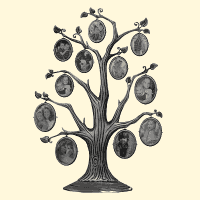
It is important to understand that the person in the diagram symbolizes a separate branch of the family. Since children have parents, moving the family tree diagram deeper into the family, a geometric progression is formed, which, if comprehensive information is available, looks like this: from each nameplate, two arrows go upward towards the father and mother. The wife of a male representative is located to his right, and brothers and sisters, if they exist, are to his left, and so on ad infinitum. In the picture of the simplified family tree table attached to this part of the article, we have placed an example from Russian genealogy with direct descendants. As you know, the surname, by Christian traditions old times, was transmitted through the male line, and, accordingly, the main branch of the clan to this day is the paternal line. This indicates that the descendant and his maternal ancestor are not directly related. But this does not mean that women should be absent from the family tree chart. The 21st century is here, males and females have equal rights, which is typical for our time.
The history of Russian childbirth is surprisingly diverse and the materials in this article on the family tree will not be redundant if we do not consider cases with adopted children or “foundlings”. Since in our practice of conducting genealogical research We sometimes come across similar turns of events in the growth of a family, then the instructions in this regard are as follows: the adopted baby is placed on the family tree diagram along with the native one, just like adopted children, because legally they become full members of the family. It would not be superfluous to mention the situation when a child was adopted into a family from an orphanage. However, if it is not possible to trace the parents through the line of such children, further construction of a family tree diagram into the depth of their family, unfortunately, is completed.
Family tree - what to consider when studying
Above was laid out on shelves family tree diagram based on relatives whose existence is known, but what about representatives of the family from past generations? After all, grandparents usually cannot talk about them. Let us immediately note that the process of studying the history of a family’s pedigree with the origin of a surname in state archives and other institutions, although interesting, is difficult and contains many pitfalls. If you want to save time and nerves by entrusting the work to professionals in the field of genealogy, we recommend ordering a family tree from Livemem, receiving, based on the results of historical research, reliable documents with confirmed authenticity and a well-designed family chart. However, you can become familiar with your own history on your own, since you have already understood the principle of compiling a family tree table; all that remains is to understand how to move deeper into the family along the selected branches, linking the family chains into a single whole.

Let us divide the task of forming a family tree table in the direction of the ancestor of the surname into several main directions for collecting materials about the origin of the dynasty:
1) Interview the family and identify the starting point;
2) Search for mentions of the family name on the Internet;
3) Work in archives with documents and connection between generations;
4) Collection of information in ancestral villages and local libraries.
At every stage of the search for ancestors, in order to draw up a diagram of the family tree, you will encounter resistance, and sometimes even misunderstanding - be prepared for this. For example, some people do not really like to remember their past due to the presence of complexes or unpleasant events. Interviewing older generations may be complicated by memory impairment in older family members; do not delay this stage and try to complete it as early as possible, in a favorable environment. Searching online for genealogy sites and related resources with historical information is problematic due to the presence huge amount spam and false information. Operating only with data from the World Wide Web, you risk creating the wrong family tree for your family. Do not forget that in our country there is a law on personal data, but despite all this, there is a possibility of stumbling upon valuable materials. Read more about searching for ancestors in archives in the corresponding article on our website, and here we will provide short description nuances of working in specialized institutions.
Working in archives is a different story, here you sometimes have to provide a basis for conducting tree research (evidence of relationship with the required surnames), and study genealogical sources for a long time and carefully with illegible handwriting, which was used to fill out most documents until the 20th century. It is not uncommon that in cities with a population of over a million people have to wait in line for a whole month to visit the reading room or obtain the necessary files from the archival fund, since the main state archives are located in regional centers with a large population. These factors negatively affect a person’s motivation, and, as a result, the desire to explore family tree may disappear altogether. Also, each establishment sets its own set of rules, such as a ban on photography, which is why you can wait for more than one week for a photocopy of the original to be made. In villages, unfortunately, things are not so simple either; people are often found drunk and hearing their story about the village can be problematic, however, local residents are often happy to make contact. But we believe in you, having a worthy goal, you will definitely achieve success, because whoever seeks will always find!
If you have any additions, please let us know in the comments and we’ll make a useful resource together!
All rights reserved, text copying is permitted only with a link to the site.
Convenient and to a certain extent free program to independently create a family tree. The program is integrated with its own website, which helps you search for relatives in family trees built by other users.
 Every family, if you look hard enough, will undoubtedly have a very long and interesting story. However, not everyone can remember this story. Moreover, the average person does not even remember all of his relatives.
Every family, if you look hard enough, will undoubtedly have a very long and interesting story. However, not everyone can remember this story. Moreover, the average person does not even remember all of his relatives.
Usually such memory is limited to memories of grandparents (at most, about someone from the great) ... But the history of a family can stretch its roots far into bygone centuries, and sometimes even millennia!!! Out of interest in ancestors, the science of genealogy emerged - a systematic collection of information about the origin, succession and relationship of surnames and clans. In a broader sense, it is the science of family ties in general.
You don't have to be some kind of scientist to do genealogy. Today, anyone can capture and trace the history of their family. To do this, you need to have some knowledge about your ancestors, a computer and one of the special programs.
I suggest using the program as an example Family Tree Builder. This free application allows you not only to capture your family tree, but even to find your relatives by comparing the family trees of other participants in the international project to which the program provides access.
At the moment, the Family Tree Builder project competes with another international genealogy project, Family Tree Maker:
Comparison of the Family Tree Builder program with the paid analogue Family Tree Maker
The paid project has a slightly larger database, but Family Tree Builder is quickly catching up with its competitor by allowing each user to post information about themselves on their personal website! Thus, it can be considered not only as a separate program, but also as a kind of social network.
However, to access it you still need to install the application, so now we’ll do just that.
Installing Family Tree Builder
Open the downloaded archive and run the installer. In the first window we will be asked to choose one of 35 languages:

Select “Russian” and click “Ok”, after which a standard application installation wizard will appear, in which you specify the necessary parameters, following the prompts.
If everything is done correctly, then after installation you will see the following window:
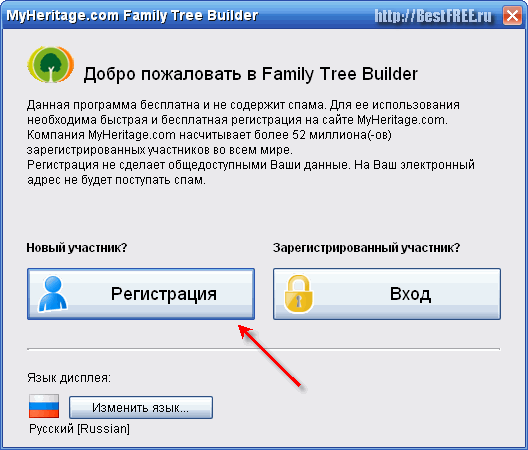
To continue working we will need to go through a procedure free registration on the project website. This will allow you to access features such as publishing your family tree online and searching for relatives.
During the registration process, you will need to fill out several forms. The first one is mandatory:

Here you need to indicate your personal data, address Email(serves as a login to enter the project) and password to access your account. In the second form, you can optionally fill in the fields with information about your place of residence, after which registration will be completed, which you will be informed about in the window that opens.
Launching Family Tree Builder
Before launching the program, you will be asked to pay for a premium account:
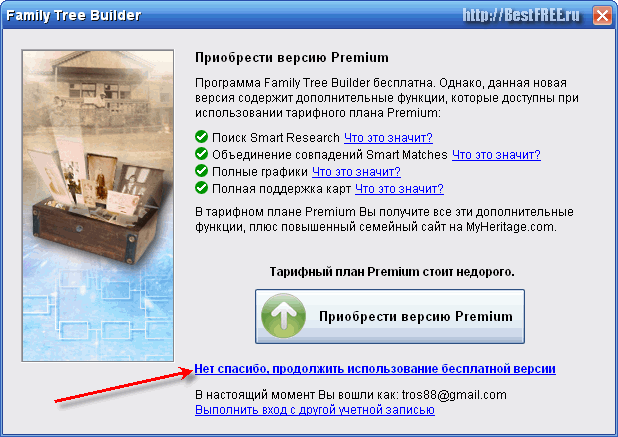
For more than $6 a month, we are offered an improved search for relatives, expanded versions of publishing family tree graphs, as well as the ability to independently work with maps and labels on them. In addition, among other bonuses, the limit on the number of entries in the family tree (online) is lifted and the space for your family website on the Internet is increased.
However, you can do without any frills and continue to use the free version of the program by clicking the appropriate link (see screenshot above).
Program interface
And now the Family Tree Builder working window will open in front of us:
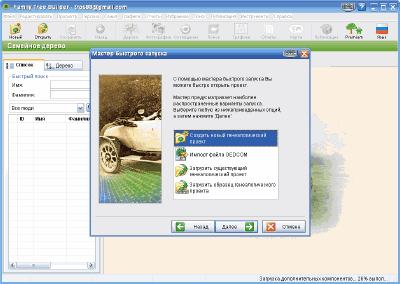
When we first launch the program, it will often give us advice on creating a new family tree project, which will allow us to quickly get used to it. First, we need to select the “Create a new genealogy project” option, and then give it a name on English language(can be translated).
On this preparatory stage will be completed. Now the program will offer to add a family with which the family tree will begin:

To do this, click the corresponding button in the work area and follow the prompts of the wizard that appears. In the first window you will need to enter data about the husband and wife of the family being created:

Here, pay attention to the button with the image of a light bulb next to the “Place” item. By clicking on it, you can clarify the location of a specific settlement so that it can be displayed correctly on the world map.
After adding the first family, we will be able to specify the parents of the husband and wife, as well as the children of a given married couple. To do this, just click on the appropriate fields on the genus diagram. If you need to add other family members (brothers, sisters, etc.), then you will need to select the desired option from the “Add person” list:
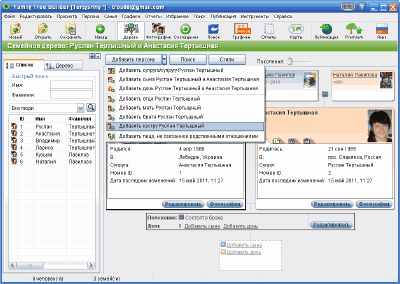
Pay attention to the left panel with a list of family members. We can reflect this list in the form of a tree, distributed among individual families. This representation can be useful when working with a large family tree:

Adding photos
As a matter of fact, up to this point we have been working in the first tab - “Tree”, however, when you look at the toolbar, you will find several additional sections. And the next one will be “Photos”:
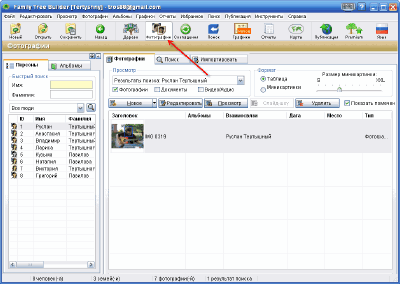
If you created your first posts using the wizard, then you have already worked on adding photos, but if not, then here you will be given such an opportunity. For each family member, you can add several photos, highlighting their faces. And if you want, you can even create a small electronic photo album by sorting the pictures you need in the “Album” section (panel on the left).
In addition to photos, you can also add short videos, audio recordings and documents related to a specific family member!
Search for relatives
The next button - “Matches” - allows you to compare information about all members of your family with the contents of online databases for identical records, which may indicate a relationship with other network users!
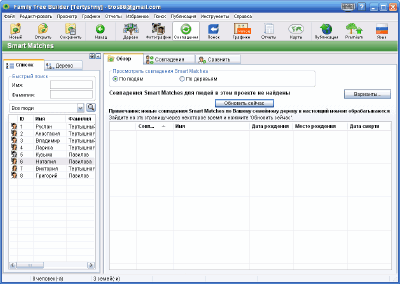
Who knows, maybe you will be lucky to find your distant relatives...
If no matches were found, try a more thorough search using the following button:

Everything is simple here too. You can try to search for all the people in the tree, which can take quite a lot of time, or you can search for matches for each family member separately. However, there are some requirements and restrictions on the use of this search method. The requirements include the need to dub the first and last name in Latin, as well as the availability of additional information (date of birth, place of residence, etc.) in English.
The limitation of the free version is the inability to view search results (we will only see whether matches were found and how many there are).
Genealogical tree design
A truly useful and enjoyable feature is the ability to decorate your family tree:

To access this function, use the “Graphs” button. By clicking it, we can select the desired type of tree and then design it according to our preferences. For example, here's what an ancestor plot might look like:
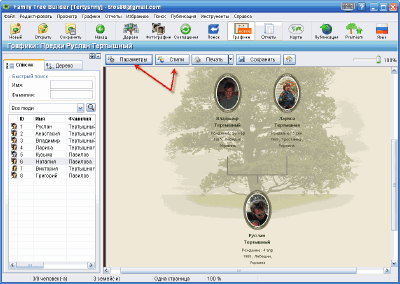
The finished template can be slightly (or even completely) changed using the “Styles” and “Options” sections. "Styles" provide the opportunity to completely change appearance family tree by choosing one of several possible options registration And “Options” allow you to customize certain decorative elements in the selected style. You can print the finished family tree or save it in JPG or PDF formats.
There is also a paid function for ordering poster printing, which you can give as a souvenir to your loved ones!
If you do not need aesthetic delights, but just want to get clear information about your relatives, then you can use the “Reports” section:

For example, using the “Relationships” item, you can see how related you are to which family member.
The next item - “Maps” - will allow you to track everything geographical coordinates related to your family:
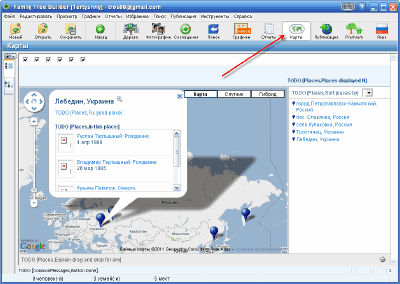
And finally, the last functional button is “Publish”. This button opens a wizard for uploading your data to the Internet and then creating your personal family website:

On this site you can trace your entire genealogy, add media content related to your family, and also maintain a small family blog. In addition, you can visit the blogs of other network members, and also get access to some entertainment features. Among the latter, it is worth noting the “Memory” game (we select pairs of photographs of our ancestors), as well as services for searching for similarities with celebrities and determining who the child is more like:
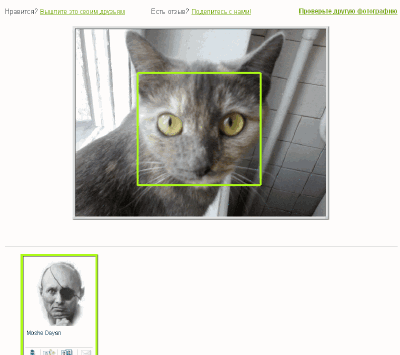
Pros and cons of Family Tree Builder
The only drawback is the need to connect to the Internet. However, if we consider that the number of users without access to the Internet is rapidly decreasing every year, then this circumstance can also be interpreted as an advantage.
After all, with the tools that this program has, we can not only create a detailed family tree of our kind, but also search for relatives on the Internet, communicate with other network users, exchange photos and videos, and even write our own blog.
Try working with Family Tree Builder, and you will find that creating a family tree can be not only routine, but also a very pleasant and exciting process;)
P.S. Permission is granted to freely copy and quote this article, provided that an open active link to the source is indicated and the authorship of Ruslan Tertyshny is preserved.
Most people sooner or later think about who their ancestors were: nobles, peasants, merchants, and maybe royal blood flowed in some persons. Perhaps the craving for the world of art is explained by the fact that my great-great-grandfather was an artist? After such reasoning, some firmly decide to find out as much information as possible about their roots and create their own family tree. Some have enough information gleaned from the stories of relatives, while others go further, even going as far as traveling to the lands of their ancestors and visiting their burial places, because tombstones may well become sources of valuable data. Let's consider the nuances of searching for information and the principles of drawing up a pedigree.
You should start by searching and collecting information about all your ancestors. This information may include their full name, dates of birth, marriage, service and death (its cause is also important, since it can be an inherited disease), class affiliation, place of work and position, name of the educational institution from which they graduated, whether he was baptized, a description of appearance and character, etc. Ask your relatives about this, study the family archive (annotated photo diaries, letters, various certificates, employment and military records, diplomas), make copies of all available documents. Systematize the information you have already received, you can start keeping a genealogy book or list, a search diary, which you can supplement with data obtained later. This way you won't get confused by the information you find.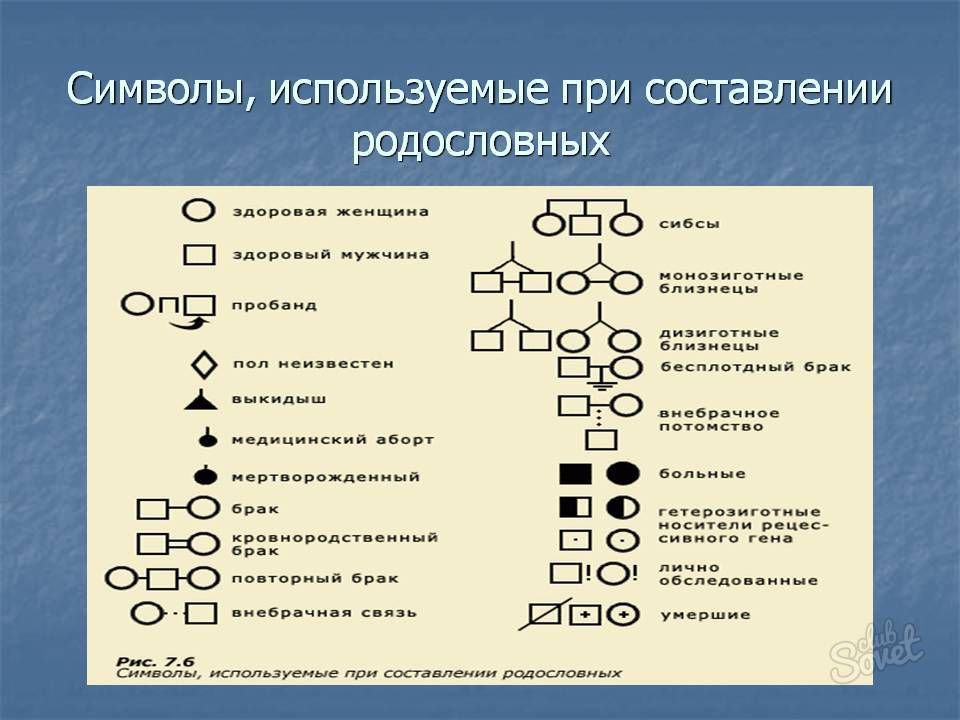
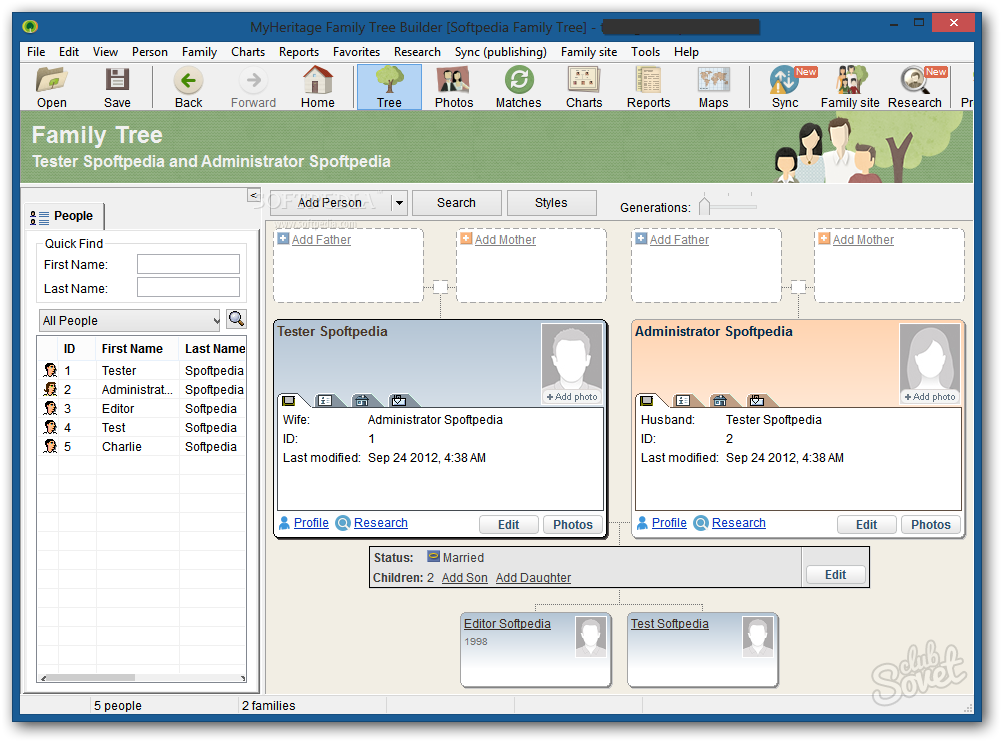
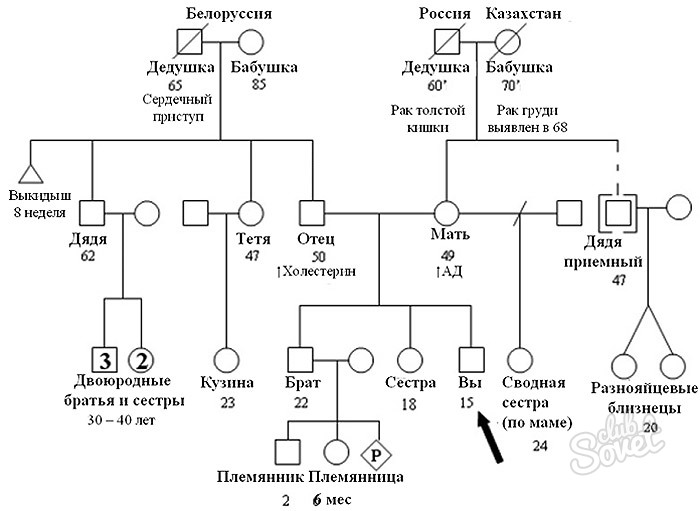
Don't forget to number your family tree, generations - in Roman numerals, and tree members - in Arabic.



















